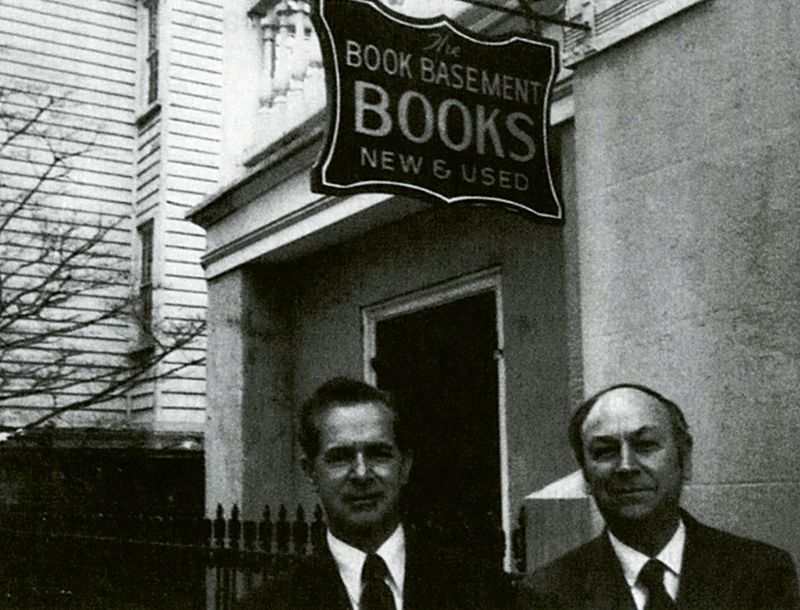In mid-century Charleston, The Book Basement served equally as shop, salon, and safe space

From 1946 to 1971, Edwin Peacock (above, at left) and John Zeigler ran The Book Basement in a College Street house that had been in Zeigler’s family for nearly a century.
For those tracking literary Charleston, there are many shrines to seek: you can walk Sullivan’s Island where Poe roamed, see Porgy’s “Catfish Row” on Church Street, or visit the homes of the writers who made Charleston famous in the 1920s and ’30s. Just as important is the site of The Book Basement, where John Zeigler and Edwin Peacock, two men in love with literature and each other, created a world where everyone—the Below Broad elite, bohemians, artists, academics, and others—were welcomed to meet, mingle, and create new chapters (and verse) in the cultural history of the city.
The Book Basement opened on the ground floor of John’s aunts’ house at 9 College Street on February 19, 1946—the birthday of iconic Southern writer Carson McCullers. She had long been a friend of Edwin’s; a fellow Georgia native, he had introduced her to books and music and ideas, and eventually to her future husband, Reeves. She used the hard-of-hearing Edwin as a model for her deaf central character in The Heart Is a Lonely Hunter. (No one could have been humbler than Edwin Peacock; McCullers’s character is named “Singer” just as ironically).
John and Edwin had met on Sullivan’s Island right before the outbreak of World War II and stayed in touch during their years in the Navy. Settled back in Charleston, their plan was for John to finish his novel and for Edwin to garden, but the store took off, quickly pulling them into the city’s cultural life. Originally from Manning, South Carolina, John had founded the literary magazine The Shako at The Citadel, wrote plays, and published poetry. As for Edwin, he’d never met a stranger. People started dropping in for browsing, conversation, a seat by the fire, a cup of tea. On Saturday afternoons, they came to hear radio broadcasts from the Metropolitan Opera, but no matter the hour, music filled the bookstore’s tiny rooms.

The pair hosted a book signing (right) to celebrate the 1948 release of A Sword from Galway by Charleston native Katherine Drayton Mayrant Simons.
John and Edwin’s good friend, lithographer Prentiss Taylor, designed the store’s postcard; he, Langston Hughes, and Maurice Sendak were among the artists and literati who visited frequently.
Edwin and John were also members of the NAACP, served on the city’s interracial committee, and welcomed black customers during a time when segregation ruled. They faced discrimination themselves as a gay couple, yet even as witch hunts tried to hound homosexuals away from town, they were out and open to all—and were always invited to events as a couple.
For 25 years, the pair ran their combination book store, salon, retreat, and safe space for writers, readers, and believers in creativity, conviviality, and civility. It came to an end in 1971 when the College, expanding as a state institution, commandeered the property.
During retirement, if they weren’t traveling the world visiting friends, John and Edwin were entertaining in their house on Wentworth Street. Edwin loved to roller skate and look for money in the street to turn over to charity; he died suddenly in 1989, just before turning 80.

Edwin in the shop’s back hall circa 1950.
John lived on to see himself portrayed in a stage adaptation of Jeb and Dash, a group biography of the network of friends he had known in Washington, DC, in the 1930s. For years, he was a familiar sight at classical concerts and musical series, and he took many budding musicians under his wing, even putting them, and Spoleto performers, up in his home. His nearly $1 million of contributions to musical scholarships launched many a career and brought numerous artists to the College and this country.
To his earlier book of poems, Alaska and Beyond, John added The Edwin Poems in 2007, then published an autobiography. He died at 103, gracious and giving, cherished by a coterie of friends and family who will never forget his wit and hospitality and how he and his beloved Edwin bookended a remarkable era in the cultural life of our city.
Photographs (Book Basement sign) from Edwin and John: A Personal History of the American South by James T. Sears [Routledge, 2009]) & courtesy of (3) Special Collections, College of Charleston Libraries